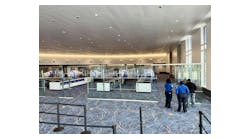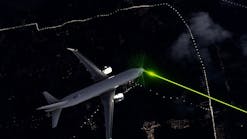The aviation industry agrees on at least one thing … a successful airport needs to balance how it secures passengers, employees, aircraft and cargo with protecting the steady revenue stream that funds it all. Too much security or too little airport revenue results in chaos. How to reach and maintain that point of equilibrium though is a subject of endless debate and the point where sparks begin to fly.
“The heart of airport security is that it’s always in competition for resources, money and manpower,” says Tom Anthony, director of Aviation Safety and Security at the University of Southern California (USC). “That means an airport and its regulators must always be looking at what security measures are reasonable considering the limits of those resources.”
Airport security versus economics is actually an older argument than most people realize, says Anthony who served as the FAA’s manager of civil aviation security for the FAA’s Western-Pacific Region prior to coming to USC. “Security is always in a constant state of evolution,” he says. “The early relationship between airport security and law enforcement, for instance, goes back to 1972 when three convicts hijacked Southern Flight 49 from Birmingham, Ala., and threatened to crash it into a nuclear power plant. In those days, the screening checkpoints were only a few yards from the actual gate, so if someone had a gun, it was just a short run to the airplane.” Not only did that hijacking convince people to pull the checkpoints further back from the gate, but it also fostered the need to physically search people prior to takeoff, an effort that began in 1973. And so it began.
Because of the dynamics of airport security Anthony says, “Every time a new FAA or ICAO security measure took hold, the bad guys would change their tactics and then we’d have to change ours.”
As a result, not all threats airports face are easily detected, as the November shooting at Los Angeles International Airport (LAX) proved. But some of the potential threats the Transportation Security Administration (TSA) faces seem almost gnawingly stupid more than 12 years after 9/11. During the first week of November 2013, the TSA confiscated 29 handguns at screening checkpoints; 27 of which were loaded. Despite the bad publicity TSA employees sometimes receive, their job will continue until people stop offering excuses like, “I forgot that .357 was in my briefcase,” for trying to carry loaded guns through security.
There’s no question that the quality of screening for passengers, their luggage and cargo has increased exponentially since 9/11. Christopher Bidwell, the Airports Council International’s (ACI) North American vice president for security and facilitation says, “I think the number of guns confiscated each week is indicative of the TSA’s effectiveness.”
Still news reports show the good, the bad and the ugly in the TSA world. The move toward risk-based security quickly comes to mind among the good, stories about corruption and crime among TSA employees often shows up as the bad, and the ugly—at least these days—seems to be the TSA’s move to stop manning exit lanes, just a couple months after an alleged breach of an exit lane at LAX cost a TSA agent his life.
Risk-based Security
TSA Administrator John Pistole is on the right track with the agency’s recent focus on risk-based screening that allows TSA to use technology to make intelligence-driven decisions at security checkpoints, according to Anthony. While some might call this profiling--and in a way it is, profiling isn’t always a dirty word. Should we really spend the same amount of time and money screening U.S. Supreme Court Justices when they travel as we do screening someone convicted of multiple weapons felonies?
Anthony says it’s time we acknowledge, “You can’t protect everyone from everything all the time. You must put your resources where they will provide the greatest protection.”
This service-focused strategy is also behind the TSA’s recent roll out of its TSA Pre? program at more than 100 airports nationwide. This program is for passengers willing to share more information up-front, once, in order to later move through the security system more freely. To date, the TSA reports more than 25 million fliers have used the security program since its rollout in 2011.
And, at the beginning of this month, the TSA gave TSA Pre? another shot in the arm when it announced plans to open a registration website and sign-up centers at major airports nationwide. Three-hundred enrollment centers are planned, and Pistole reported in a recent news release that the move will further aid the TSA in focusing on high-risk passengers while reducing hassle for low-risk ones.
“TSA Pre?is enabling us to move away from a one-size-fits-all approach to transportation security,” he said.
Perhaps this information-rich world is beginning to finally help airport security become better organized. On the upside, Anthony says, “I think security and the level of professionalism [from TSA employees] has increased.”
Exit lanes controversy
But just when some critics were starting to believe the TSA was getting better at the great security balancing act came word that the agency plans to return exit lane screening tasks to local airport authorities on January 1, whether or not they want it.
The TSA currently staffs exit lanes at approximately one-third of the nation’s airports. Other airports either bear the responsibility themselves or share the responsibility with the TSA. And a few, including airports in New York, New Jersey, Washington and Nevada have begun installing unmanned automated exit lanes.
According to TSA spokesman Ross Feinstein, transferring that task to airports would allow the agency to train its focus on screening passengers and baggage, and would trim $88 million from its budget.
Thought the move seems to make financial sense as far as the TSA budget is concerned, the TSA outraged the industry when it announced the change as an amendment to the Airport Security Program, rather then through an NPRM (notice of proposed rulemaking) that would have offered users a chance to comment.
Anthony says, “When it comes to exit lanes, that’s an example of dynamic shared responsibility in aviation security. Each party has its own duties and certainly there will be areas of gray where those responsibilities overlap. But the security side cannot forget that it is only one gear in a complicated transmission of aviation and aviation security. Neither side [security or airports] can exist independent of the other. Understanding that has been one of TSA’s challenges.”
Part of the exit lane argument is just naming the problem. Neither the TSA nor the airport industry agrees on whether they are talking about screeners or monitors. A TSA spokesperson claims: “The exit lane monitors are not actually screeners,” but monitors.
However, Bidwell says the screening function at exit lanes is clear, at least to them. “With the verification of armed law enforcement officers (LEOs) conducted by TSA officers at exit lanes, TSA has been performing screening functions in these locations for some time,” he says. “More recently, through the implementation of the Known Crewmember (KCM) program, TSA routinely screens pilots and flight attendants at exit lanes.”
Bidwell says ACI finds screening should only be conducted by federal employees. The specifics of funding a variety of the TSA’s Aviation Security Infrastructure Fee-based functions is detailed in the February 20, 2002, Federal Register grid outlining screening personnel cost categories. There at least, exit lane personnel are listed as monitors, not screeners.
Another major stumbling block to the exit lane controversy is the cost. Though the TSA’s financial impact study shows the agency is poised to save millions by the move, airports won’t fare nearly as well. Bidwell predicts filling these positions will cost airports an estimated $160 million each year, or about $204,000 each annually. According to ACI, the cost to procure, install and operate the technology needed to monitor exit lanes alone could run from hundreds of thousand to as much as $1.5 million per exit lane if a fully automated monitoring system is installed.
Interestingly, when TSA dumps the exit lane functions next month, it will continue charging the full Aviation Security Infrastructure Fee that funds its side of the work.
Many airports have filed petitions with the TSA asking the organization to reconsider its decision. Others have teamed with their Congressional representatives in an attempt to have the ruling rescinded or delayed. Still others are reportedly considering filing lawsuits.
Despite the short time frame until implementation, the ACI has no plans on rolling over on exit lanes. Bidwell says that’s because, “We see this issue in its totality. The TSA cost impact study was flawed because it failed to account for many costs, like some wage issues, a problem that ACI says makes the TSA’s plan unrealistic. ACI and its members have written letters to Pistole, members of Congress, the chairman and ranking members of the Homeland Security committee and even U.S. Attorney General Eric Holder.
In a November 8, letter to Pistole, Senators James Inhofe (R-PA), Tim Scott (R-SC) and Robert Menendez (D-NJ) urged the administrator to withdraw the exit lane amendment to the Airport Security Program citing not only the cost to airports, but taking specific issue with the manner in which the TSA chose to implement the program, by an amendment, rather than an NPRM, which would have offered more people an opportunity to comment on the proposal.
“The TSA overstepped its authority by imposing this amendment,” Bidwell says. “This exit lane proposal represents a very costly unfunded mandate.”
But the TSA says the January 2014 implementation date stands. And, some airports have begun preparing for this latest TSA push to unbalance the system--because TSA assistance or not, exit lanes need staffing to keep airports secure.


